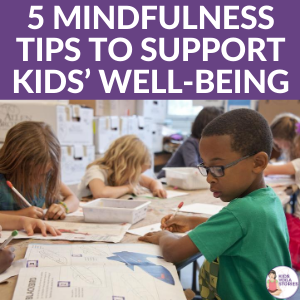7 Mindfulness Myths to Bust!
Do you feel something is holding you back from introducing mindfulness practices to your children? Are you not sure what mindfulness really is? Cassandra Troughton, our Community Coordinator, helps us bust 7 mindfulness myths.
Sometimes, we wait and wait and wait…
We wait forever for that perfect moment…
But does that perfect moment ever come?
This was me when I returned to teaching at my little elementary school after COVID shut our world down…
Before, I ran a Mindfulness Club during recess. I had a perfect fifteen minutes three times a week to practice mindfulness with my kiddos.
But upon returning to school, everything was different. And everyone was separated.
I waited and waited for the perfect moment to bring mindfulness back to my kids. But the restrictions never gave me my perfect moment…
Finally, I realized I couldn’t wait anymore for the perfect moment. It might never come.
I had to go out and create my own moments of mindfulness. And so… I did!
Quite often, we have this perception of mindfulness in our heads. We assume we need to do mindfulness “perfectly” and that we need the perfect moment to get started.
But sometimes that idea just holds us back from beginning in the first place!
That is why, today, I am going to go through some mindfulness myths!
We’ll bust these myths, which might be holding you back from getting started, so you get over the hump of implementing mindfulness practices into your life!
7 Mindfulness Myths!
MYTH #1: Mindfulness is Meditation
While meditation can be a form of mindfulness, mindfulness is NOT meditation. Meditation is an ancient practice that originated from India. This ancient practice has been adopted by many religions, such as Buddhism and Hinduism. Because meditation has been incorporated into some religions, many people confuse mindfulness as a religious practice, as well.
Mindfulness is NOT religious, though. It is NOT a practice… It is a state of being! It does not require you to sit in any particular position, to close your eyes, or even to be still. Mindfulness is simply being in the present and being aware, without judgment, at any point in the day.
Mindful Moment Action Item:
You can easily tap into mindfulness during your natural daily transitions just by taking a DEEP BREATH! Focusing on our breathing grounds us in the present. So, the next time you switch activities—such as going home from work or before starting a meal—take a deep belly breath in through your nose and let everything go as you exhale!
MYTH #2: Mindfulness is a Quiet Activity
We tend to think that mindfulness needs silence. This mindset can hold us back or make us feel defeated when working with kids. It can be so hard to keep kids quiet!
Silence is not necessary, though. You can do ANY activity mindfully. You can listen to music mindfully. You can have mindful conversations. You can work as a team mindfully. You can play catch mindfully. The only rule is that you are present and fully engaged in the activity.
Mindful Moment Action Item:
Let’s work on having mindful conversations! How many times do you find yourself responding to a text message while you’re in the middle of a face-to-face conversation? Or how often do you find yourself listening to RESPOND, instead of listening to LISTEN?
Instead, let’s have intentional conversations that are grounded in the present moment. Put away your phone and other distractions. Focus on the person in front of you. Focus solely on them and their words. Let them finish their thoughts before preparing your response.
MYTH #3: Mindfulness is Too Hard
Sometimes we don’t even feel like implementing mindfulness into our lives because it just seems too hard. We are constantly in our own heads and over thinking. We over think about how hard it is to STOP thinking.
We need to reframe the way we see mindfulness. It’s a skill. And like any other skill, it becomes easier with practice. Anyone can build in the habit of mindfulness by intentionally exposing yourself to small mindful moments each day.
Mindful Moment Action Item:
Having a more mindful day is easier when we begin the day with mindfulness. Try starting off your day in gratitude! Upon awakening, think of one to three things to be grateful for. You can write them down if you wish, but even just THINKING thoughts of gratitude will do wonders. It will set the motion for your day!
MYTH #4: Mindfulness is Only for Adults
Mindfulness is for EVERYONE! Regardless of your age, your gender, or even your capabilities, mindfulness is for YOU. We tend to assume that mindfulness doesn’t work for kids who can’t stay quiet. Sometimes, it even gets called a “feminine activity” because boys are (supposedly) too rambunctious. But this is not true!
Mindfulness does not require you to sit still or be quiet. Mindfulness simply requires paying attention. And ANYONE can learn to pay attention. Anyone can remain in the present moment with enough practice.
Mindful Moment Action Item:
Do you want to know the best way to work on paying attention? Focusing on one task at a time. Yes, that means I’m talking about eliminating multitasking for good! We are not processing computers.
We are not designed to split our attention between more than one task at a time. That’s why when we multitask, we often aren’t very productive. It doesn’t work as well as we think. AND it takes us out of the present moment.
Try single tasking. Focus on one item at a time. Mindfulness at its finest!
MYTH #5: Mindfulness Means Emptying your Mind
How many of you quit attempting mindfulness because it’s impossible to clear your mind? I know I used to be guilty of this one. The thing is… You don’t have to clear your mind. You don’t have to stop thinking thoughts. We all have thoughts, and sometimes these thoughts take over.
When we practice mindfulness, we are able to step outside of those thoughts. We can notice them without judging them. Simply let them pass and refocus ourselves in the present, on our breathing. We HAVE thoughts, but our thoughts are NOT who we are.
Mindful Moment Action Item:
Another way to implement mindfulness into your day is to separate your sense of self from your thoughts. We can do so by reframing how we call out our feelings. We tend to say or think, “I am angry… I am sad… I am defeated…” Instead, add in the word feeling before the emotion. “I am feeling angry… I am feeling sad… I am feeling defeated.”
In doing so, you are mindfully separating yourself from your thoughts. It’s okay to have thoughts and feelings. Mindfulness helps us understand that our thoughts aren’t a permanent part of us.
MYTH #6: A Mindfulness Practice is Time Consuming
This is one of the biggest reasons people put off practicing mindfulness. They think they have to sit quietly for twenty minutes or thirty minutes… or even an hour each day. Who has an extra hour out of their day to spare?!
Good thing that this is another MYTH! You don’t need to carve out time for mindfulness. All you need to do is continue to do your everyday activities—but with mindfulness in mind!
Mindful Moment Action Item:
What do you think about while you brush your teeth? Do you brush your teeth while doing other things? Do you brush your teeth while getting breakfast started? What about while you’re frantically looking in your closet for clothes to wear?
Let’s slow it down. How about shutting out the extra noise and focusing solely on teeth brushing. Notice all the sensations. How do your bristles feel on your teeth and gums? What does your toothpaste taste like? Glide your tongue on your teeth to feel the smoothness afterward. Mindful teeth brushing!
MYTH #7: Mindfulness is Only Good for your Mental Health
Yes, mindfulness is AMAZING for our mental health. It’s ALSO good for our physical health! Amazing things happen to our entire body when we practice mindfulness. When we practice mindfulness, it slows down our nervous systems. When we slow down our nervous systems, it improves the function of our body systems.
Because our bodies aren’t wasting energy managing stress, that energy is directed to other areas of the body—like the immune system! And our immune system keeps us healthy and strong when it’s running at its best! It’s important to know that mindfulness has positive implications on our physical health too!
A quick note on that: For individuals who’ve experienced significant trauma, they may want to refer to a professional when it comes to implementing mindfulness in their lives.
Mindful Moment Action Item:
Practice mindfulness as you eat! Did you know that it is not healthy for us to eat in front of the TV—because it’s not mindful! When we eat mindlessly, we don’t get to enjoy our food. We scarf it down, and we overeat. Instead, sit down at the dinner table with your family.
Focus all your senses on the food in front of you. Slow it down and notice not only how it tastes. Notice also how it feels, how it smells, how it looks. Even how it sounds as you chew. When we eat mindfully, we eat more proportionally. We even enjoy it more!
I hope this inspires you to take action to begin living more mindfully. There is no reason you can’t start today!
Pause for a moment and assess your days. What daily activities do you currently have scheduled in your days? Is there a way you can do those activities with mindfulness in mind?
Can you be present for them?
Yes, you can!
I believe in you!
There is no better day to get started than today!
CHECK OUT MINDFUL KIDS IN 10 MINUTES A DAY
MINDFULNESS MADE EASY… 3 PACK SPECIAL!
Get all three workbooks for a very special price!
Mindful Kids in 10 Minutes a Day: Preschool-2nd Grade (Value: $19.95)
Mindful Kids in 10 Minutes a Day: 3rd – 5th Grade (Value: $19.95)
Mindful Moments for Middle Schoolers (Value: $19.95)
These done-for-you workbooks will provide you with daily activities to help kids find quietude, calm, and focus in the midst of their otherwise-busy day.
ABOUT THE AUTHOR

Cassandra Troughton (a.k.a. Miss T) is an educational assistant from Canada. She has worked with Edmonton Public Schools for over seven years, primarily in the special needs adaptability program (Gr. 1-6) and as the Health and Wellness lead at her school in Edmonton, Alberta. Her passions include health, wellness, and the practice of mindfulness! She loves passing on her knowledge of mindfulness to her students and fellow educators. You can find her at https://mindfulmisst.com/. She is currently the Community Coordinator of Kids Yoga Stories.
PIN IT FOR LATER















